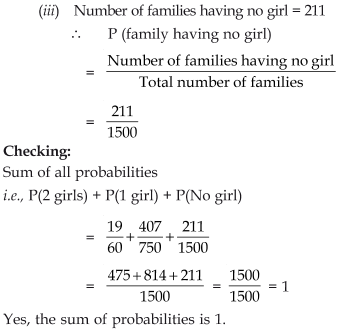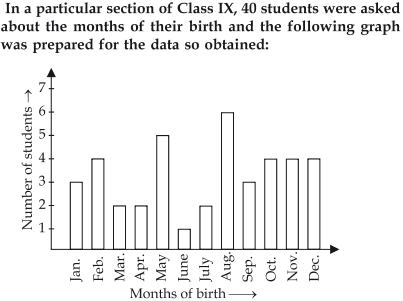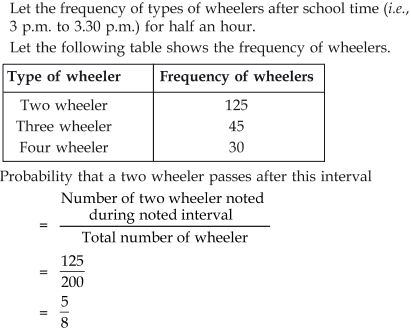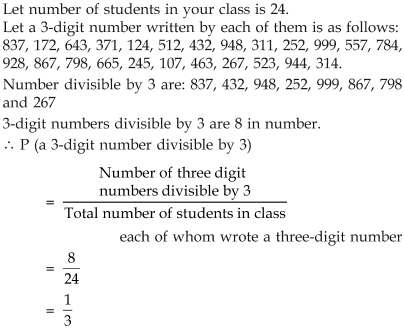NCERT Solutions for Chapter 15 Probability Class 9 Maths
Book Solutions1
Answer
Here, the total number of trials = 30∵ Number of times the ball touched boundary = 6
∴ Number of times, the ball missed the boundary = 30 – 6 = 24
Let the event not hitting the boundary be represented by E, then
Thus, the required probability = 0.8
2
1500 families with 2 children were selected randomly, and the following data were recorded:
| Number of girls in a family | 2 | 1 | 0 |
| Number of families | 475 | 814 | 211 |
Compute the probability of a family, chosen at random, having
(i) 2 girls
(ii) 1 girl
(iii) No girl
Also check whether the sum of these probabilities is 1.
Answer
Total number of families = 1500.(i) ∵ Number of families having 2 girls in a family = 475


3
Refer to Example 5, Section 14.4, Chapter 14. Find the probability that a student of the class was born in August. 
Answer
From the graph, we have:
Total number of students born in various months in a year = 40
Number of students born in August = 6
∴ Probability of a student of the IX-Class who was born in August = (6/40)= (3/20)
4
Three coins are tossed simultaneously 200 times with the following frequencies of different outcomes:
| Outcome | 3 heads | 2 heads | 1 head | No head |
| Frequency | 23 | 72 | 77 | 28 |
If the three coins are simultaneously tossed again, compute the probability of 2 heads coming up.
Answer
Total number of times the three coins are tossed = 200Number of outcomes in which 2 heads coming up = 72
∴ Probability of 2 heads coming up = (72/200) = (9/25)
Thus, the required probability = (9/25)
If the three coins are simultaneously tossed again, then the probability is (9/25)
5
An organisation selected 2400 families at random and surveyed them to determine a relationship between income level and the number of vehicles in a family. The information gathered is listed in the table below:
| Monthly income
On ₹) | Vehicles per family | |||
| 0 | 1 | 2 | Above 2 | |
| Less than 7000 | 10 | 160 | 25 | 0 |
| 7000-10000 | 0 | 305 | 27 | 2 |
| 10000-13000 | 1 | 535 | 29 | 1 |
| 13000-16000 | 2 | 469 | 59 | 25 |
| 16000 or more | 1 | 579 | 82 | 88 |
Suppose a family is chosen. Find the probability that the family chosen is
(i) earning ₹ 10000–13000 per month and owning exactly 2 vehicles.
(ii) earning ₹ 16000 or more per month and owning exactly 1 vehicle.
(iii) earning less than ₹ 7000 per month and does not own any vehicle.
(iv) earning ₹ 13000–16000 per month and owning more than 2 vehicles.
(v) owning not more than 1 vehicle.
Answer
Here, total number of families = 2400(i) ∵ Number of families having earning ₹ 10000– ₹ 13000 per month and 2 vehicles = 29
∴ Probability of a family (having earning ₹ 10000–13000 and 2 vehicles) =
(ii) ∵ Number of families having earning ₹16000 or above and owning 1 vehicle = 579
∴ Probability of a family (having earning ₹ 16000 and above and 1 vehicle) =
(iii) ∵ Number of families having earning less than ₹7000 and does not own any
vehicle = 10
∴ Probability of a family (having earning less than ₹ 7000 and owning no vehicle) =
(iv) ∵ Number of families having earning ₹13000–16000 and owing more than 2 vehicles = 25
∴ Probability of a family (having earning ₹13000–10000 and owning no vehicle) =
(v) ∵ Number of families owning not more than 1 vehicle
= [Number of families having no vehicle] + [Number of families having only 1 vehicle]
= [10 + 1 + 2+ 1] + [160 + 305 + 535 + 469 + 579]
= 14 + 2148
= 2162
∴ Probability of a family (owning not more than one vehicle) =
6
Refer to Table.
(i) Find the probability that a student obtained less than 20% in Mathematics test.
(ii) Find the probability that a student obtained 60 marks or above.
| Marks | Number of students |
| 0–20
20–30 30–40 40–50 50–60 60–70 70 and above | 7
10 10 20 20 15 8 |
| Total | 90 |
Answer
From the table 14.7, we have:Total number of students = 90
(i) From the given table number of students who have obtained less than 20% marks = 7
⇒ Probability of a student (obtaining less than 20% marks) = (7/90)
(ii) From the given table, number of students who obtained marks 60% or above
= [Number of students in class-interval 60–70] + [Number of students in the class interval 70 and above]
= 15 + 8 = 23
⇒ Probability of a student (who obtained 60 marks and above) = (23/90)
7
To know the opinion of the students about the subject statistics, a survey of 200 students was conducted. The data is recorded in the following table.
| Opinion | Number of students |
| Like
Dislike |
135
65 |
Find the probability that a student chosen at random
(i) likes statistics,
(ii) does not like it.
Answer
Total number of students whose opinion in obtained = 200(i) ∵ Number of students who like statistics = 135
∴ Probability of a student (who likes statistics) =
(ii) ∵ Number of students who do not like statistics = 65
∴ Probability of a student (who dislike statistics) =
8
(i) less than 7 km from her place of work?
(ii) More than or equal to 7 km from her place of work?
(iii) Within (1/2) km from her place of work?
Answer
Total number of engineers = 40(i) ∵ Number of engineers who are living within less than 7 km from their work place = 9
∴ Probability of an engineer living within 7 km from work place = (9/40)
(ii) ∵ Number of engineers living at a distance more than or equal to 7 km from their work place = 31
∴ Probability of an engineer living at a distance more than or equal to 7 km = (31/40)
(iii) ∵ The number of engineers living within (1/2) km from their work place = 0
∴ Probability of an engineer who is living within (1/2) km from work place = (0/40) = 0
9
Activity: Note the frequency of two-wheelers, three-wheelers and four-wheelers going past during a time interval, in front of your school gate. Find the probability that any one vehicle out of the total vehicles you have observed is a two-wheeler.
Answer

10
Activity: Ask all the students in your class to write a 3-digit number. Choose any student from the room at random. What is the probability that the number written by her/him is divisible by 3?
Answer

11
4.97 5.05 5.08 5.03 5.00 5.06 5.08 4.98 5.04 5.07 5.00
Find the probability that any of these bags chosen at random contains more than 5 kg of flour.
Answer
Total number of bags = 11∵ Number of bags having more than 5 kg of flour = 7
∴ Probability of a bag (Having more than 5 kg wheat flour) = (7/11)
12
The data obtained for 30 days is as follows:
0.03, 0.08, 0.08, 0.09, 0.04, 0.17, 0.16, 0.05, 0.02, 0.06, 0.18, 0.20, 0.11, 0.08, 0.12, 0.13, 0.22, 0.07, 0.08, 0.01, 0.10, 0.06, 0.09, 0.18, 0.11, 0.07, 0.05, 0.07, 0.01, 0.04
Answer
Total number of days = 30∵ The number of days (on which the sulphur dioxide concentration is in the interval 0.12–0.16) = 2
∴ Probability of a day (on which sulphur dioxide is in 0.12–0.16 interval) = (2/30)
= (1/15)
13
The blood groups of 30 students of Class VIII are recorded as follows:
A, B, O, O, AB, O, A, O, B, A, O, B, A, O, O, A, AB, O, A, A, O, O, AB, B, A, O, B, A, B, O.
Answer
Total number of students = 30∵ Number of students having blood group as AB = 3
∴ Probability of a student (whose blood group is AB) = (3/30) = (1/10)